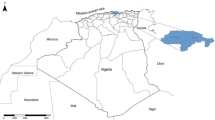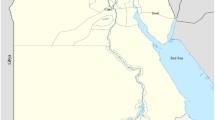Abstract
In this study, the investigation on the prevalence of Coxiella burnetii antibodies in cattle dairy farms (n = 44) associated with a history of abortions /and reproductive disorders located in various geographical areas in different states of India was carried out. A total of 323 serum samples (n = 323) collected from apparently healthy cattle associated with a history of abortions, infertility, repeat breeding, anoestrus, endometritis, etc., were screened for anti-C. burnetii antibodies by employing PrioCHECK™ Ruminant Q Fever AB Plate ELISA Kit. The overall seropositivity of 44.0% (142/323, 95% confident interval: 39–49%) was observed in cattle with the presence of antibodies associated with abortions and other reproductive disorders (χ2 = 18.75, p < 0.01). Further, the seropositivity of the dairy farms [84.1% (37/44)] implies at least one or two animals in each farm was found to be positive for C. burnetii antibodies. Moreover, on screening of the serum samples from seronegative and seropositive dairy farms, by Trans PCR, 84 out of 107 samples were found positive for C. burnetii genomic DNA, which indicated the ongoing active infection in all the studied farms. This study revealed that C. burnetii infection was prevalent in dairy cattle associated with abortions, infertility, and other reproductive problems and it implies the cattle have a role as a reservoir and may act as a potential zoonotic source to farm associated risk-groups personnel namely farmers, animal handlers, veterinarians, etc., that necessitates the adoption of appropriate mitigating strategies to reduce the incidence of Q fever in cattle dairy farms.

Similar content being viewed by others
References
Shome R, Deka RP, Milesh L, Sahay S, Grace D, Lindahl JF (2019) Coxiella seroprevalence and risk factors in large ruminants in Bihar and Assam, India. Acta Trop 194:41–46
Chang CC, Lin PS, Hou MY, Lin CC, Hung MN, Wu TM, Shu PY, Shih WY, Lin JHY, Chen WC, Wu HS, Lin LJ (2010) Identification of risk factors of Coxiella burnetii (Q fever) infection in veterinary-associated populations in southern Taiwan. Zoonoses Public Health 57:e95–e101
Kersh GJ, Fitzpatrick K, Pletnikoff K, Brubaker M, Bruce M, Parkinson A (2020) Prevalence of serum antibodies to Coxiella burnetii in Alaska Native Persons from the Pribilof Islands. Zoonoses Public Health 67:89–92
Pradeep J, Kumar S, Stephen S, Kamboj D, Gunasekaran D, Hanifah M (2018) Detection of acute Q fever human cases by indirect immunofluorescence and real-time polymerase chain reaction in a tertiary care hospital in Puducherry. Indian J Med Res 148:449–452
OIE (2018) Chapter 3.1.1: Q fever. Manual of diagnostic tests and vaccines for terrestrial animals 2019. OIE, Paris
Arricau-Bouvery N, Rodolakis A (2005) Is Q fever an emerging or re-emerging zoonosis? Vet Res 36:327–349
Sidi-Boumedine K, Rousset E, Henning K, Ziller M, Niemczuck K, Roest HIJ, Thiery R (2010) Development of harmonised schemes for the monitoring and reporting of Q-fever in animals in the European Union. EFSA Support Publ 7:48E
ECDC (2010) Panel with representatives from the Netherlands, France, Germany, United Kingdom, United States of America. Risk assessment on Q fever. ECDC Technical Report: European Centre for Disease Prevention and Control
Muskens J, van Engelen E, van Maanen C, Bartels C, Lam TJ (2011) Prevalence of Coxiella burnetii infection in Dutch dairy herds based on testing bulk tank milk and individual samples by PCR and ELISA. Vet Rec 168:79
Anderson AD, Baker TR, Littrell AC, Mott RL, Niebuhr DW, Smoak BL (2011) Seroepidemiologic survey for Coxiella burnetii among hospitalized US troops deployed to Iraq. Zoonoses Public Health 58:276–283
Stephen S, Chandrashekara I, Rao KN (1980) Natural occurrence of Coxiella burnetii in the brown dog tick Rhipicephalus sanguineus. Indian J Med Res 71:865–869
Pexara A, Solomakos N, Govaris A (2018) A review on the seroprevalence of Coxiella burnetii in farm ruminants in various countries. Vet Ital 54:1113
Chakarabarthy A, Bhattacharjee PK, Sarker RR, Rahman AKM, Henning K, Neubauer H, Rahman MS (2016) Prevalence of Coxiella burnetii infection in cattle, black bengal goats and ticks in Bangladesh. Bangladesh J Vet Med 14:65–68
Stephen S, Sangeetha B, Antony PX (2014) Seroprevalence of coxiellosis (Q fever) in sheep and goat in Puducherry and neighbouring Tamil Nadu. Indian J Med Res 140:785–787
van der Hoek W, Dijkstra F, Schimmer B, Schneeberger PM, Vellema P, Wijkmans C, ter Schegget R, Hackert V, van Duynhoven Y (2010) Q fever in the Netherlands: an update on the epidemiology and control measures. Eurosurveillance 15:19520
Pradeep J, Stephen S, Ambroise S, Gunasekaran D (2017) Diagnosis of acute Q fever by detection of Coxiella burnetii DNA using real-time PCR, employing a commercial Genesig easy kit. J Clin Diagn Res 11:10–13
Vaidya VM, Malik SV, Bhilegaonkar KN, Rathore RS, Kaur S, Barbuddhe SB (2010) Prevalence of Q fever in domestic animals with reproductive disorders. Comp Immunol Microbiol Infect Dis 33:307–321
Keshavamurthy R, Singh BB, Kalambhe DG, Aulakh RS, Dhand NK (2019) Prevalence of Coxiella burnetii in cattle and buffalo populations in Punjab. India Prev Vet Med 166:16–20
Dhaka P, Malik SS, Yadav JP, Kumar M, Baranwal A, Barbuddhe SB, Rawool DB (2019) Seroprevalence and molecular detection of coxiellosis among cattle and their human contacts in an organized dairy farm. J Infect Public Health 12:190–194
Vaidya VM, Malik SV, Kaur S, Kumar S, Barbuddhe SB (2008) Comparison of PCR, immunofluorescence assay, and pathogen isolation for diagnosis of q fever in humans with spontaneous abortions. J Clin Microbiol 46:2038–2044
Snedecor GW, Cochran WG (1967) Statistical methods, Indian. Oxford & IBH Publishing, New Delhi
Berri M, Laroucau K, Rodolakis A (2000) The detection of Coxiella burnetii from ovine genital swabs, milk and fecal samples by the use of a single touchdown polymerase chain reaction. Vet Microbiol 72:285–293
Das DP, Malik SV, Rawool DB, Das S, Shoukat S, Gandham RK, Saxena S, Singh R, Doijad SP, Barbuddhe SB (2014) Isolation of Coxiella burnetii from bovines with history of reproductive disorders in India and phylogenetic inference based on the partial sequencing of IS1111 element. Infect Gent Evol 22:67–71
Thrusfield M (2005) Veterinary epidemiology, 3rd edn. Blackwell Publishing Professional, Ames
Johnson SAM, Kaneene JB, Asare-Dompreh K, Tasiame W, Mensah IG, Afakye K, Simpson SV, Addo K (2019) Seroprevalence of Q fever in cattle, sheep, and goats in the Volta region of Ghana. Vet Med Sci 5:402–411
Selim A, Ali AF, Moustafa SM, Ramadan E (2018) Molecular, and serological data supporting the role of Q fever in abortions of sheep and goats in northern Egypt. Microb Pathog 125:272–275
Esmaeili S, Mohabati Mobarez A, Khalili M, Mostafavi E (2019) High prevalence and risk factors of Coxiella burnetii in milk of dairy animals with a history of abortion in Iran. Comp Immunol Microbiol Infect Dis 63:127–130
Rousset E, Berri M, Durand B, Dufour P, Prigent M, Delcroix T, Touratier A, Rodolakis A (2009) Coxiella burnetii shedding routes and antibody response after outbreaks of Q fever-induced abortion in dairy goat herds. Appl Environ Microbiol 75:428–433
Gunaydin E, Pekkaya S, Mustak HK, Dalkilic B (2014) Investigation of Q fever in Kilis and Shamil goats by ELISA and touchdown-PCR. Ankara Universitesi Veteriner Fakultesi Dergisi 61:161–165
Lorenz H, Jager C, Willems H, Baljer G (1998) PCR detection of Coxiella burnetii from different clinical specimens, especially bovine milk, on the basis of DNA preparation with a silica matrix. Appl Environ Microbiol 64:4234–4237
Acknowledgements
The authors wish to thank the Indian Council of Agricultural Research (ICAR), New Delhi, India, for providing facilities and financial support of the Project (OXX02232) to carry out the research work and the ICAR-NIVEDI for constant support and encouragement always. The first author would like to thank and acknowledge Dr. Sandeep Chaudhary, Professor, and Head, Department of Public Health and Epidemiology, Nagpur Veterinary College, MAFSU, Maharashtra, India for his kind gift of a recombinant positive clone. The authors also thank the ICAR-NIVEDI staff for their continuous support and timely help to execute the research work.
Funding
This work was carried out with funding support from the ICAR-Network project on Outreach Programme on Zoonotic Diseases (OPZD) (F. No. 14 (1) / 2009-ASR IV and AS/1(1)/2017-ASR IV), ICAR, DARE, MoAFW, GOI.
Author information
Authors and Affiliations
Corresponding author
Ethics declarations
Conflict of interest
The authors declare that they have no conflict of interest.
Statement of Animal Rights
The manuscript does not contain animal experimental trial. No ethical clearance is required for collecting small volumes of blood samples required for seroepidemiological studies, as per CPCSEA (Committee for the Purpose of Control and Supervision of Experiments on Animals) guidelines. Moreover, samples were collected by well-trained veterinarians concerning animal welfare regulations for the diagnosis of disease.
Additional information
Publisher's Note
Springer Nature remains neutral with regard to jurisdictional claims in published maps and institutional affiliations.
Significance Statement
Active C. burnetii infection was recorded in both seronegative and seropositive cattle dairy farms. There is evidence for cattle as a reservoir host and may act as a potential zoonotic source.
Rights and permissions
About this article
Cite this article
Balamurugan, V., Alamuri, A., Kumar, K.V. et al. Prevalence of Coxiella burnetii Antibodies in Dairy Cattle Associated with Abortions and Reproductive Disorders. Proc. Natl. Acad. Sci., India, Sect. B Biol. Sci. 91, 353–359 (2021). https://doi.org/10.1007/s40011-021-01226-1
Received:
Revised:
Accepted:
Published:
Issue Date:
DOI: https://doi.org/10.1007/s40011-021-01226-1




